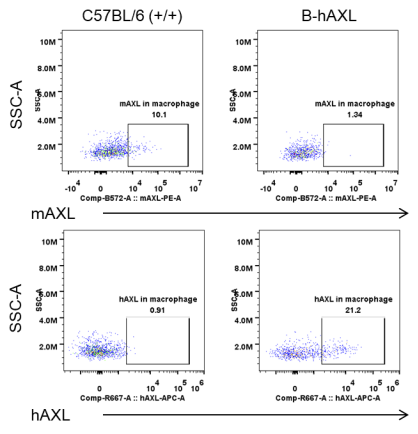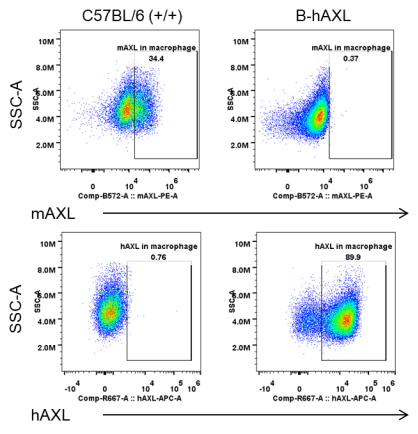中文
B-hAXL mice
| Strain Name |
C57BL/6-Axltm1(AXL)/Bcgen
|
Common Name | B-hAXL mice |
| Background | C57BL/6 | Catalog number | 110908 |
|
Related Genes |
AXL (ARK; UFO; JTK11; Tyro7) | ||
|
NCBI Gene ID |
26362 | ||
模型验证
Model description
Axl encodes a member of the Tyro3-Axl-Mer (TAM) receptor tyrosine kinase subfamily. The encoded protein possesses an extracellular domain which is composed of two immunoglobulin-like motifs at the N-terminal, followed by two fibronectin type-III motifs. It transduces signals from the extracellular matrix into the cytoplasm by binding to the vitamin K-dependent protein growth arrest-specific 6 (Gas6). This gene may be involved in several cellular functions including growth, migration, aggregation and anti-inflammation in multiple cell types. The TAM receptors (Tyro3, Axl and MerTK) are promising therapeutic targets on tumor-associated macrophages. The TAM receptors are a family of receptor tyrosine kinases with shared ligands Gas6 and Protein S that skew macrophage polarization towards a pro-tumor M2-like phenotype. In macrophages, the TAM receptors also promote apoptotic cell clearance, a tumor-promoting process called efferocytosis. The TAM receptors bind the "eat-me" signal phosphatidylserine on apoptotic cell membranes using Gas6 and Protein S as bridging ligands. The Gas6/AXL signalling pathway is associated with tumour cell growth, metastasis, invasion, epithelial-mesenchymal transition (EMT), angiogenesis, drug resistance, immune regulation and stem cell maintenance. Different therapeutic agents targeting AXL have been developed, typically including small molecule inhibitors, monoclonal antibodies (mAbs), nucleotide aptamers, soluble receptors, and several natural compounds.

Strain specific AXL expression analysis in homozygous B-hAXL mice by flow cytometry. Splenocytes were collected from wild-type C57BL/6 mice (+/+) and homozygous B-hAXL mice (H/H). Flow cytometry analysis of the macrophage was analyzed with species-specific anti-AXL antibody. Mouse AXL was detectable in wild-type mice. Human AXL was exclusively detectable in homozygous B-hAXL mice but not in wild-type mice.

Strain specific AXL expression analysis in homozygous B-hAXL mice by flow cytometry. Peritoneal washes were collected from wild-type C57BL/6 mice (+/+) and homozygous B-hAXL mice (H/H). Flow cytometry analysis of the macrophage was analyzed with species-specific anti-AXL antibody. Mouse AXL was detectable in wild-type mice. Human AXL was exclusively detectable in homozygous B-hAXL mice but not in wild-type mice.
【2】Zhu C, Wei Y, Wei X. AXL receptor tyrosine kinase as a promising anti-cancer approach: functions, molecular mechanisms and clinical applications. Mol Cancer. 2019;18(1):153. Published 2019 Nov 4. doi:10.1186/s12943-019-1090-3
【3】Tanaka M, Siemann DW. Gas6/Axl Signaling Pathway in the Tumor Immune Microenvironment. Cancers (Basel). 2020;12(7):1850. Published 2020 Jul 9. doi:10.3390/cancers12071850
Copyright © 2024 百奥赛图江苏基因生物技术有限公司. All Rights Reserved
备案号: 苏ICP备2021053911号-1
 苏公网安备:32068402320845号
网站建设:北京分形科技
苏公网安备:32068402320845号
网站建设:北京分形科技
 苏公网安备:32068402320845号
网站建设:北京分形科技
苏公网安备:32068402320845号
网站建设:北京分形科技






 010-56967680
010-56967680 info@bbctg.com.cn
info@bbctg.com.cn